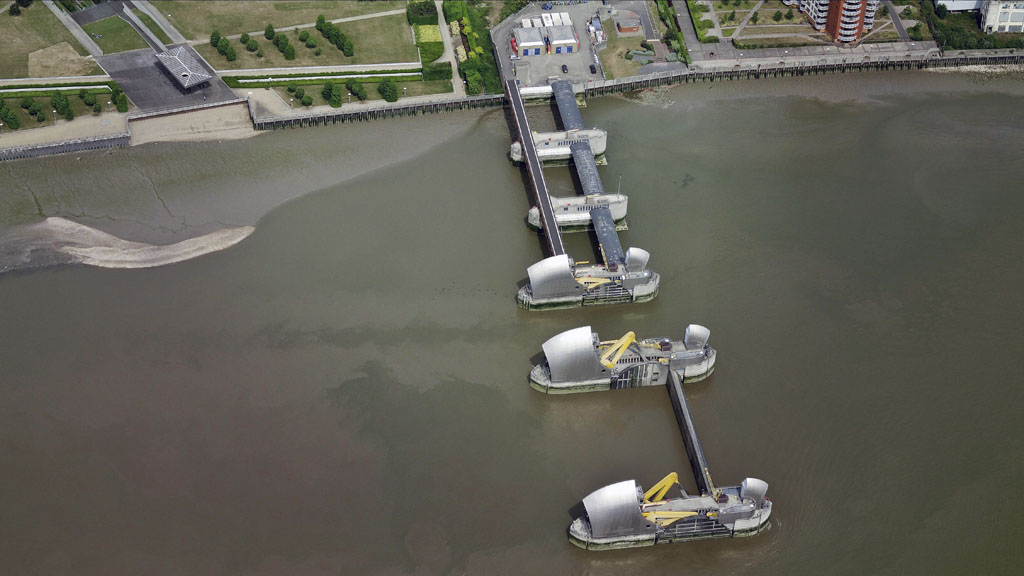Floods crisis: is London in danger?
The Thames Barrier has been protecting the capital for more than 30 years. But how long will it be able to hold out against rising sea levels?

The barrier, which has been in operation since 1982, is being used now to help regulate the swollen waters of the Thames and stop flooding west of London reaching the capital.
The Environment Agency (EA) has issued more than a dozen severe flood warnings along the Thames west of London from Datchet in Berkshire to Shepperton Green, Surrey.
The Thames is expected to continue to rise in the Thames Valley after weeks of heavy rain.
East of London, some 25 miles downstream, the barrier is being used to make sure the Thames does not burst its banks in the centre of the city.
The barrier’s vital role reflects the fact that the Thames estuary is the place where the freshwater Thames is met twice a day by the incoming tide from the North Sea, making water levels rise and fall by 7m.
At the moment the 10 3,300-tonne steel gates of the barrier are being raised at mid-tide, preventing the incoming seawater slowing the swollen river down as it tries to drain eastwards into the estuary.

The barriers can be lowered again when the tide goes out, quickly carrying floodwater east through London and out into the sea.
Of course the barrier is also there to protect against flooding from the storm surges which frequently roll in from the North Sea, threatening to swamp London from the east.
Andy Batchelor, operations manager at the Thames Barrier, told us there was “no risk to the centre of London” from the current flooding in Berkshire and Surrey thanks to his team’s constant monitoring of tide and surge.
More from Channel 4 News: Floody hell - Britain's battle with the weather in pictures
He said: “What we are doing now is a bit different because the tide is so big. When the tide goes up it’s a bit like two forces working against each other.
“We are seeing extremely high flows coming down the Thames, but by us operating the barrier, we are just removing that part of the tide that would have slowed up the flow and caused some further flooding upstream.
“If it rains heavily in Oxford or Reading, ultimately that rain has to pass through London to get out to the sea.”
What if?
The Thames Barrier was built following the devastating floods of 1953, when a North Sea surge killed more than 300 people.
Mr Batchelor told us: “Things like the Thames Barrier are there because we made the decision not to raise the flood defences in the centre of London.
“By building the barrier in the east of London, we didn’t have to add three metres to the Embankment. London would have looked totally different if you weren’t able to see the river.”
If the 520m barrier had not been built near Woolwich, huge areas of London would be at risk from flooding.
About 15 per cent of all properties in the capital are built on the Thames floodplain, according to the EA.
In December 2013, following the biggest North Sea storm surge for 60 years, the agency published this map showing the probable effect on central London if no barrier had been in place.

The barrier keeps more than 1 million people and £200bn worth of property dry, including historic landmarks like the Houses of Parliament, the Canary Wharf business district and most of the London Underground network.
But the risk of flooding appears to be rising as sea levels rise, and the barrier will not last forever.
The EA says the barrier has been raised 141 times since 1982, but the need is becoming more frequent. It was closed more than 100 times since 2000 and 13 times in January alone.
.jpg)
Experts say that if there are 50 closures a year, it is time to start improving the tidal defence system.
The EA’s current forward plan, called Thames Estuary 2100, estimates that we will have to replace the barrier in about 2070.
According to the latest climate change predictions, this is the point when the rising sea levels mean storm surges could come crashing over the top of the barrier.
Of course, nothing can guarantee absolute protection against really extreme weather.
The Thames Barrier and the other barriers and flood gates near it are currently thought to offer protection against everything but a freak once-in-1,000-years event.